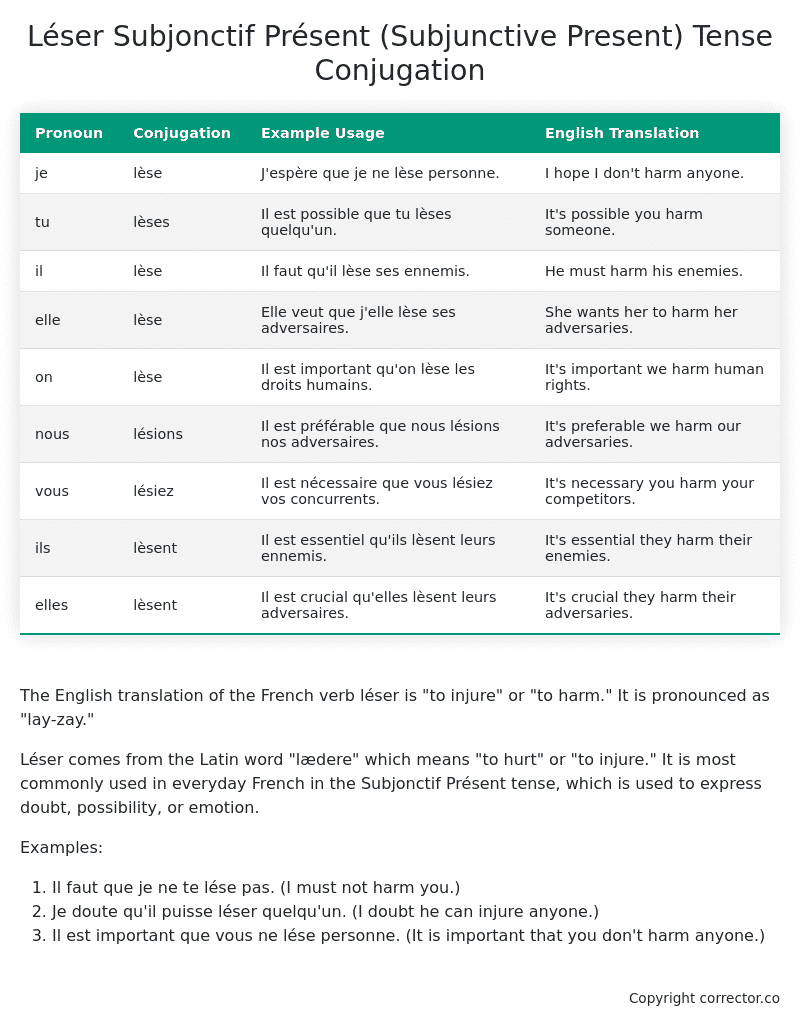Subjonctif Présent (Subjunctive Present) Tense Conjugation of the French Verb léser
Introduction to the verb léser
The English translation of the French verb léser is “to injure” or “to harm.” It is pronounced as “lay-zay.”
Léser comes from the Latin word “lædere” which means “to hurt” or “to injure.” It is most commonly used in everyday French in the Subjonctif Présent tense, which is used to express doubt, possibility, or emotion.
Examples:
- Il faut que je ne te lése pas. (I must not harm you.)
- Je doute qu’il puisse léser quelqu’un. (I doubt he can injure anyone.)
- Il est important que vous ne lése personne. (It is important that you don’t harm anyone.)
Table of the Subjonctif Présent (Subjunctive Present) Tense Conjugation of léser
| Pronoun | Conjugation | Example Usage | English Translation |
|---|---|---|---|
| je | lèse | J’espère que je ne lèse personne. | I hope I don’t harm anyone. |
| tu | lèses | Il est possible que tu lèses quelqu’un. | It’s possible you harm someone. |
| il | lèse | Il faut qu’il lèse ses ennemis. | He must harm his enemies. |
| elle | lèse | Elle veut que j’elle lèse ses adversaires. | She wants her to harm her adversaries. |
| on | lèse | Il est important qu’on lèse les droits humains. | It’s important we harm human rights. |
| nous | lésions | Il est préférable que nous lésions nos adversaires. | It’s preferable we harm our adversaries. |
| vous | lésiez | Il est nécessaire que vous lésiez vos concurrents. | It’s necessary you harm your competitors. |
| ils | lèsent | Il est essentiel qu’ils lèsent leurs ennemis. | It’s essential they harm their enemies. |
| elles | lèsent | Il est crucial qu’elles lèsent leurs adversaires. | It’s crucial they harm their adversaries. |
Other Conjugations for Léser.
Le Present (Present Tense) Conjugation of the French Verb léser
Imparfait (Imperfect) Tense Conjugation of the French Verb léser
Passé Simple (Simple Past) Tense Conjugation of the French Verb léser
Passé Composé (Present Perfect) Tense Conjugation of the French Verb léser
Futur Simple (Simple Future) Tense Conjugation of the French Verb léser
Futur Proche (Near Future) Tense Conjugation of the French Verb léser
Plus-que-parfait (Pluperfect) Tense Conjugation of the French Verb léser
Passé Antérieur (Past Anterior) Tense Conjugation of the French Verb léser
Futur Antérieur (Future Anterior) Tense Conjugation of the French Verb léser
Subjonctif Présent (Subjunctive Present) Tense Conjugation of the French Verb léser (this article)
Subjonctif Passé (Subjunctive Past) Tense Conjugation of the French Verb léser
Subjonctif Imparfait (Subjunctive Imperfect) Tense Conjugation of the French Verb léser
Subjonctif Plus-que-parfait (Subjunctive Pluperfect) Tense Conjugation of the French Verb léser
Conditionnel Présent (Conditional Present) Tense Conjugation of the French Verb léser
Conditionnel Passé (Conditional Past) Tense Conjugation of the French Verb léser
L’impératif Présent (Imperative Present) Tense Conjugation of the French Verb léser
L’infinitif Présent (Infinitive Present) Tense Conjugation of the French Verb léser
Struggling with French verbs or the language in general? Why not use our free French Grammar Checker – no registration required!
Get a FREE Download Study Sheet of this Conjugation 🔥
Simply right click the image below, click “save image” and get your free reference for the léser Subjonctif Présent tense conjugation!

Léser – About the French Subjonctif Présent (Subjunctive Present) Tense
Formation of the Subjonctif Présent
Common Everyday Usage Patterns
Interactions with Other Tenses
Summary
I hope you enjoyed this article on the verb léser. Still in a learning mood? Check out another TOTALLY random French verb conjugation!


